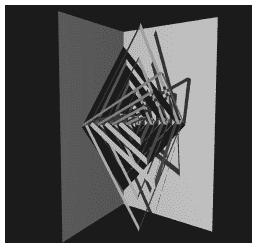This is a mind-blowing demonstration of viscosity and Stokes flow from a physics professor at the University of New Mexico:
If you think it’s ludicrous to suggest that you can un-mix a liquid, then watch the entirety of this 2-minute video!
This is a mind-blowing demonstration of viscosity and Stokes flow from a physics professor at the University of New Mexico:
If you think it’s ludicrous to suggest that you can un-mix a liquid, then watch the entirety of this 2-minute video!
This arrangement of chocolates makes me think of triangulation, the process of approximating a curved surface by a collection of flat triangles. Approximating curved things with flat things is a classic move in mathematics, and is one of the fundamental ideas in Calculus. So, maybe this photograph should be titled “Calculus in a Chocolate Shop”?
This week’s entry in the “Wow, the Internet is Awesome!” file:
http://www.youtube.com/watch?v=yVkdfJ9PkRQ
These pendula of staggered lengths are set swinging, and the result is fascinating. At first, the weights seem to trace out sine waves, but they quickly start to cycle through a wide range of behaviors.
At times the pendula appear highly organized, and at times almost chaotic, as they cycle through various patterns. Amazingly, the weights eventually return to their initial state!
A really beautiful mathematical demonstration.
I consider myself an expert arranger of things. I enjoy rearranging storage space, packing things away, and helping people fill up moving trucks. It’s a way to apply geometry and optimization techniques, two of my favorite things.
In general, the packing problem entails trying to find the most efficient way to pack a certain kind (or kinds) of object into a certain fixed space. Packing problems are, generally speaking, very challenging because every packing problem is unique. There isn’t a good, efficient procedure that solves them all.
Here is yet another example of problems with packing problems. After shedding a bunch of CD cases, I thought I’d try to pack them up in a box. Here was my first attempt.
I got 49 CDs in the box, but there was a bit of unused space left over. I couldn’t fit a CD into that unused space, but I thought maybe I could rearrange everything to make some of that space usable.
The number of CDs in this new arrangement differed by one. While I can compare which of these packings is more efficient, the problem is comparing all possible packings! There are a lot of options to consider.
As useless as they are, I ended up having a lot of fun with these CD cases. I made some parallelepipeds with them and used them to demonstrate Cavalieri’s Principle!
Related Posts
 This is great website from Joseph O’Rourke, author of “How to Fold It: The Mathematics of Linkages, Origami,and Polyhedra” .
This is great website from Joseph O’Rourke, author of “How to Fold It: The Mathematics of Linkages, Origami,and Polyhedra” .
The website has several videosand cool animations that demonstrate some of the basic ideas in mathematical folding, like the one-cut problem, the map puzzle, and folding polygons into convex polyhedra.
There are also a few folding patterns available for download, just in case you’d like to produce a turtle with one cut!
And for more resources on math and origami, check out my fun with folding page!